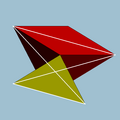Pseudo great rhombicuboctahedron
Appearance
| Pseudo-great rhombicuboctahedron | |
|---|---|

| |
| Type | Pseudo-uniform polyhedron, Star polyhedron |
| Elements | F = 26, E = 48 V = 24 (χ = 2) |
| Faces by sides | 8{3}+(8+8+2){4} |
| Symmetry group | D4d |
| Properties | singular vertex figure |
 4.4.4.3/2 Vertex figure |
 Pseudo-great deltoidal icositetrahedron (dual polyhedron) |
In geometry, the pseudo great rhombicuboctahedron is one of the two pseudo-uniform polyhedra, the other being the convex elongated square gyrobicupola or pseudorhombicuboctahedron. It has the same vertex figure as the nonconvex great rhombicuboctahedron (a uniform polyhedron) but is not a uniform polyhedron and has a smaller symmetry group. It can be obtained from the great rhombicuboctahedron by taking a square face and the 8 faces with a common vertex to it and rotating this by π/4. It is related to the great rhombicuboctahedron in the same way that the pseudo-rhombicuboctahedron is related to the rhombicuboctahedron.
Related polyhedra
The pseudo-great rhombicuboctahedron may also be termed an elongated crossed square gyrobicupola.
 Great rhombicuboctahedron |
 Pseudo-great rhombicuboctahedron |
References
- Grünbaum, Branko (2009). "An enduring error". Elemente der Mathematik. 64 (3): 89–101. doi:10.4171/EM/120. MR 2520469.
{{cite journal}}: Invalid|ref=harv(help). Reprinted in Pitici, Mircea, ed. (2011). The Best Writing on Mathematics 2010. Princeton University Press. pp. 18–31..
